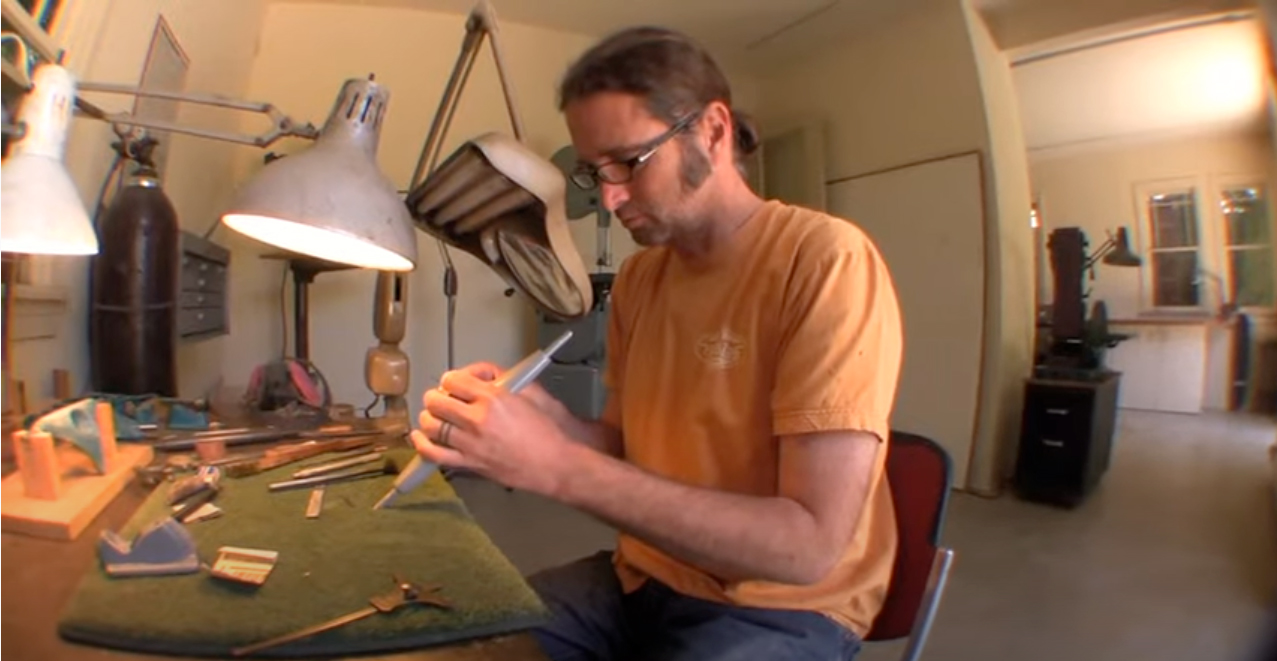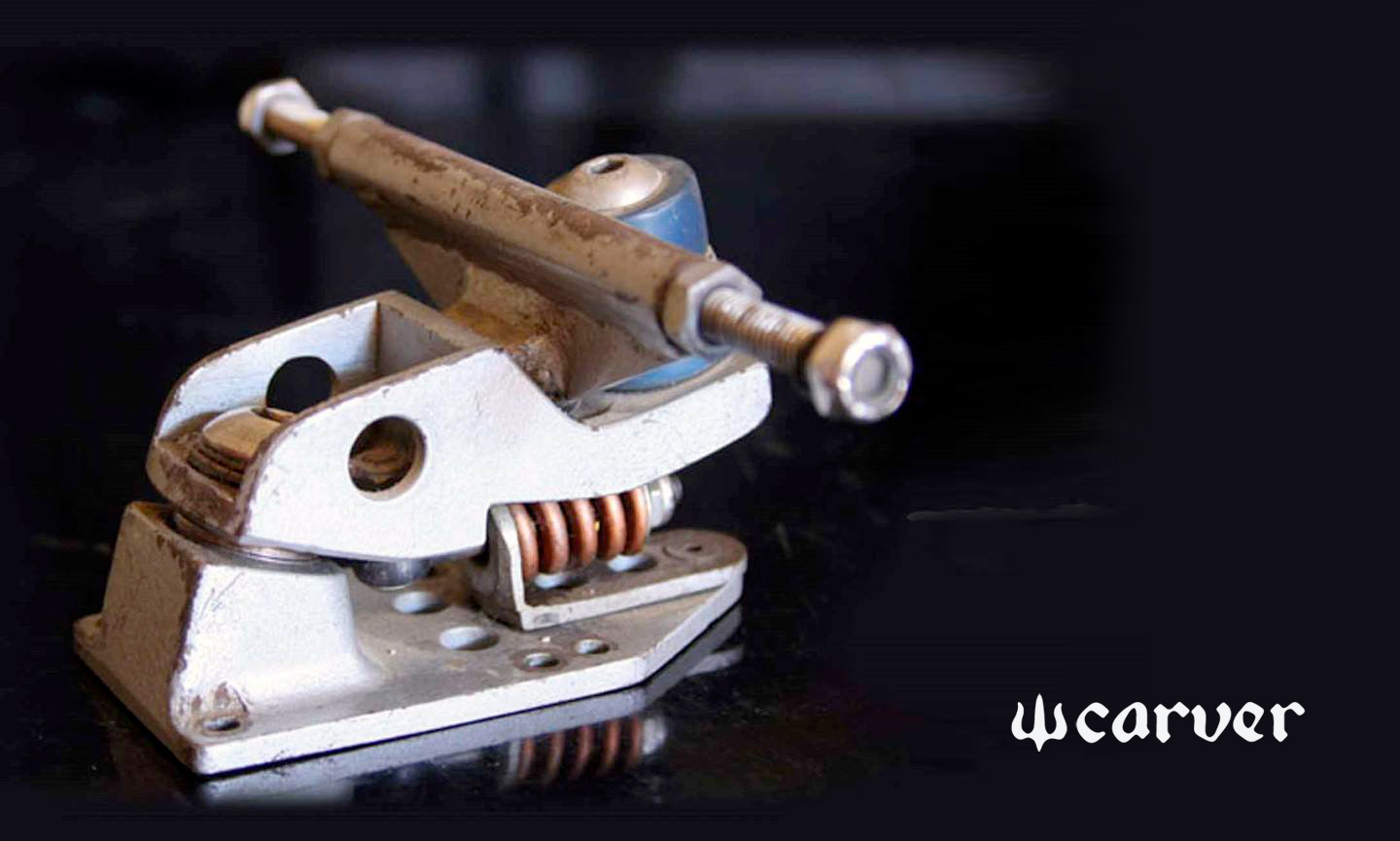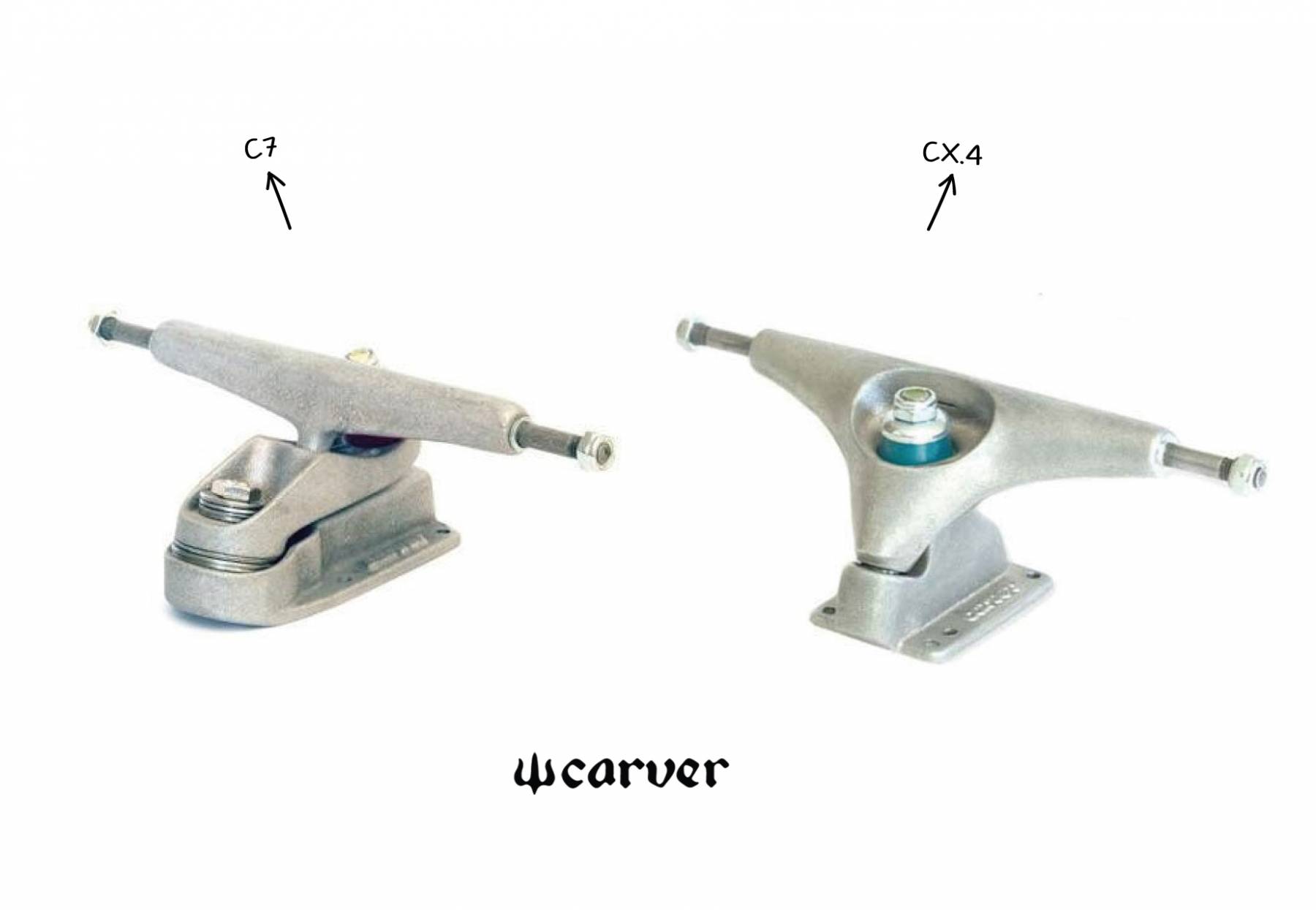Today we decided to tell you the story of Carver and the invention of their famous surfskate trucks because that of the Carver company is a story intertwined with that of the surfskate and because it is a beautiful story of how a passion has turned into a business of success thanks to the tenacity of two guys.
In fact, the Carver company was born from the passion for surfing and skateboarding of two kids looking for a little fun. Two obstinate and passionate surfers who, not finding what they wanted around, started building it with their hands, and here's how it went
1995 CARVER SURFSKATE IS BORN

Venice, California, 1995, history repeats itself. Same place, over 30 years after the invention of the first skateboards, by surfers bored by the absence of waves typical of the summer months, here we go again.
Greg Falk and Neil Carver couldn't find peace during the long summer days, due to the grueling absence of waves. Not even a longboard ripple, nothing. So, like many generations before them, they headed their skateboards to the hills to surf on the road. After all, the historic districts of Venice and Santa Monica are a real skatepark made up of steep alleys and banks, which seem to be born on purpose to be surfed, but while they threw themselves on those asphalt waves they could not help but notice how much everything this was different from surfing. Sure, they were still standing on a board and sliding, but snapping or pumping like on the wall of a wave was simply impossible. Their skateboards were too stiff.
And then, like others before them, they first of all tried to loosen the trucks as much as possible, but the only result was to make the skateboard more unstable and wobbly so that the hills became impassable. And then even with those loose trucks, the curve dynamics were still all rail-to-rail, symmetrical from nose to tail and raising the nose for the high-speed tick-tock downhill didn't seem like a good idea ... it was too much. risky and therefore they found themselves imagining what they wanted, unable to get it with the skateboards that already existed on the market.
THE FIRST SURF TRUCK PROTOTYPES
Greg and Neil soon realized the point was that at least the front truck needed more turning than the rear one to get closer to the turning dynamics of a modern thruster surfboard.
They experimented with various combinations of angled risers, very soft trucks and bushing, but they only managed to add a few degrees of curvature and the feeling was still too far from what they had in mind. What was missing was the lateral swing. So they started working on their idea and after numerous sketches, they welded the first prototype of Carver truck in the abandoned garage behind Neil's house ... Californian garages are always a source of great inspiration!
Of course their idea was not yet to market a product ... they were just trying to surf the asphalt in the absence of waves! But at the time no one skateboarded satisfied them and so instead of having fun with their skateboards on the hill they kept throwing down sketches.
The first swing arm they assembled on a skateboard didn't work very well. Even on a moderate slope it was almost impossible to drive ... perhaps because, they later realized, they had reversed the angle of the bearings!
Despite the clunky handling, there was a glimmer of the movement they wanted. Back in the shop, Neil welded a new truck with the correct angle for the thrust bearings and they headed back up the hill. Finally here is what they were looking for! All that month they did nothing but continue to surf the hill, breaking many trucks and more ...
Slowly their technique progressed but moving up steeper slopes, they soon came across the limits of their prototypes. First, they realized the arm needed some spring resistance to bring it back to center, so Greg tied a bungee cord to the end of his truck and anchored it to the bottom of the deck. Obviously it was only a temporary solution to give them more time to have fun in the hills while Neil worked on more compact spring systems.
And as the angled pivot arm now tilted the deck correctly they realized it needed a second independent axis of motion and so after many more months of drawing and design Neil finally walked into the shop to weld the first double pivot gimbal truck.
This new truck incorporated everything they had learned from their numerous tests into a fairly compact mechanism. “The afternoon I tested that prototype was the first time I really realized this could be more than an experiment. I didn't even take it up a hill, but just walked around a sloping driveway a few doors from my shop, but it was enough. I carved the smooth concrete, turned and pumped again effortlessly, ”says Neil.
“The dual axis mechanism finally allowed the board to turn with a variable rail angle, making me feel like I was surfing on the water. I stayed out on that driveway late into the night drawing eight. "
Although the surfing feeling was already good, a lot of work was still needed to turn it into something more than a handmade prototype, nevertheless many other skaters from Venice were interested in these new "carving trucks", and so Neil and Greg decided to produce their own mold.
At that time Neil was working with a third generation aluminum foundry.
So it was that together with a production partner, Neil and Greg formed their own company called Carver.
TRUCK C1
At that time Neil began designing swing arm trucks, trying to combine the dual axle concept with a small but powerful and adjustable internal spring.
Months were spent researching all kinds of spring systems looking for something that could fit the small cramped space under the truck and withstand the heavy requirements of the skateboard. It also needed to be adjustable for different weights and rider preferences.
Another important aspect was that it had to increase the resistance towards the ends, and it had to swing smoothly without "clicking" at the center point. Basically what they needed didn't exist yet.
Weeks turned into months as Neil tried to incorporate all design needs into something that was simple, robust and easy to make. After hundreds of drawings and dozens of prototypes, he finally found a solution that finally allowed him to go out and skate without having to carry a suitcase of tools.
The whole process thus far had already taken a lot longer than anyone anticipated and they still had to focus on the design of the cast parts, how they could best be made and assembled, while still remaining light and strong.
But in the end the new truck was finally ready, it was nicknamed C1 and got its first patent.
And finally these trucks have landed in the hands of surfers and skaters.
The feedback has been great. Laird Hamilton grabbed a board and quickly got his surfing style back on wheels. It was her perfect surf workout to keep fit and to ride the giant waves of Jaws. Hamilton, one of the greatest surfers and innovator of modern surfing, recognized this breakthrough in skateboarding aimed at surf training.
Carver proudly presented several Laird models and having such a surfing icon on board helped the young brand to make itself known and stand out.
Japanese professional surfer Aki Takahama, who became Carver's distributor, also felt the deep connection with surfing he had when he used his Carver, so he took some boards to Japan to see if anyone there would feel the same way and the answer. he couldn't be more enthusiastic. Famous Japanese professional surfer Mineto Ushikoshi joined the Carver team, helping design his line of decks and graphics and brought his technical approach to surfing to Carver.
Orders were coming in faster than Carver could fulfill them, and soon thousands of boards were traveling across the sea. As the Japanese scene grew, great riders emerged and developed their own distinctive style of surfskating.
THE NEW TRUCK C7 CARVER

Meanwhile, a different feedback from that of Japanese surfers was arriving in the United States. American riders wanted something more stable, easier to push, more adjustable. Back in the workshop, Neil built a new prototype with a longer spring, stiffer swing geometry and more compact thrust bearing.
Everyone preferred this version, so they once again created new molds and went into production with what finally became Carver's C7.
THE NEW TRUCK C2
With this new front truck, the old C2 rear truck needed to be redesigned to keep up. So they took this regular truck and put it through the same iterative design process that they applied to their other trucks. The new C2 has thus become a bit narrower to return to the center in a more positive way.
They also made a lower version, the C4, suitable for street skateboarding, with a reinforced sliding plate.
THE IDEA OF THE TRUCK CX
Carver had created a smooth and reliable set of road surf trucks, but while there were many riders who loved the smooth feel of the C7's adjustable spring system, others who wanted a more familiar truck that still gave them a feeling of comfort. surf. Basically, a truck more similar to a standard truck, but reconfigured in a new geometry in order to free the nose of the board and behave somewhere between a c7 and a standard skateboard truck.
"I started calling it CX because it was still a mystery to me, and instead of giving it a model number, I just typed 'X'," Neil said.
He worked on it for years, while Carver continued to grow as a company.
After nearly five years of making prototypes that didn't work, it seemed the whole idea might be a futile pursuit until some of the right tweaks finally led to the first RKP (Reverse King Pin) truck he carved and pumped, where all the others. prototypes could barely bend.
This geometry was so unique that Carver registered another patent.
Meanwhile, in 2007, brand recognition was growing, but the company was having some internal problems that seemed unable to shake off.
At the time the business was split between the manufacturing at the Eastside factory and the design office that Neil and Greg ran from Venice but Greg and Neil felt at odds with the way production was handled and without constant supervision. problems often presented themselves.
The rift between the Eastside factory and the Westside designers eventually led the company to a crossroads. After lengthy negotiations, in late 2007 Neil and Greg took over all of the company's outstanding shares and opened their own small factory in the seaside town of El Segundo.
In 2008 the Great Recession hit hard and in order not to sink they tried their best but in those years and in the following years downhill skateboarding was the fastest growing segment, and while Carver was doing very well with the surfers, downhillers were all focused on speed and had no interest in a surfskate.
THE NEW TRUCK CX 4

The Japanese concept of Kaizen, which means "continuous improvement," is woven into the culture of the brand, gradually improving everything from business operations to design and manufacturing. And so the development of the CX continued, testing new ways to get more performance from their patented geometry.
The use of new precision pivot pins and adjustable bushing seats helped accelerate the improvement. This ability to fine-tune geometry by increasing steering angles and bushing seat height has improved the performance of this new CX, so much so that the fourth generation production model has somehow surpassed the performance of the legendary C7. !
What had made Carver the surfers' choice in the past was their twin axle truck, the C7, but by now Carver had another simpler, lighter surfskate truck that pumped just as well, the CX4.
Developed in tandem with the new CX.4, the new C2.4 has been completely redesigned to evolve into a precise pivot that functions under the rear foot like a series of fins hooked to the wall of a wave. The increased action and fluidity perfectly match the front truck, integrating into a perfect blend of performance that allows for faster pumping and tighter turns with all the grip and ride properties you need to truly feel like on a board. surf.
It's been more than 25 years since that flat summer and Carver is the leader of the surfskate market today.
Today there are numerous other surfskate brands, in Japan, Australia and even in Europe, and many of them have made or are trying to make trucks modeled on the invention of the C7, with mixed results.
Carver for its part continues to make its surfskate products in America focusing on reliability and development and continuous research to drive progression forward for all surf training riders and beyond.
“I see more and more people on our boards now, and I can always tell when they are riding a Carver by the way they are surfing on their boards,” Neil says. “It's a great feeling to see how much fun they are having and to know we did it for them,” adds Greg.
And here is Neil who tells how it went in this must-see video
Pubblicato il 13 maggio 2021 | Blog > Equipments: SURFSKATE

